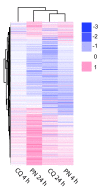Global gene expression profiling of Plasmodium falciparum in response to the anti-malarial drug pyronaridine
- PMID: 21849091
- PMCID: PMC3224238
- DOI: 10.1186/1475-2875-10-242
Global gene expression profiling of Plasmodium falciparum in response to the anti-malarial drug pyronaridine
Abstract
Background: Pyronaridine (PN) and chloroquine (CQ) are structurally related anti-malarial drugs with primarily the same mode of action. However, PN is effective against several multidrug-resistant lines of Plasmodium falciparum, including CQ resistant lines, suggestive of important operational differences between the two drugs.
Methods: Synchronized trophozoite stage cultures of P. falciparum strain K1 (CQ resistant) were exposed to 50% inhibitory concentrations (IC50) of PN and CQ, and parasites were harvested from culture after 4 and 24 hours exposure. Global transcriptional changes effected by drug treatment were investigated using DNA microarrays.
Results: After a 4 h drug exposure, PN induced a greater degree of transcriptional perturbation (61 differentially expressed features) than CQ (10 features). More genes were found to respond to 24 h treatments with both drugs, and 461 features were found to be significantly responsive to one or both drugs across all treatment conditions. Filtering was employed to remove features unrelated to primary drug action, specifically features representing genes developmentally regulated, secondary stress/death related processes and sexual stage development. The only significant gene ontologies represented among the 46 remaining features after filtering relate to host exported proteins from multi-gene families.
Conclusions: The malaria parasite's molecular responses to PN and CQ treatment are similar in terms of the genes and pathways affected. However, PN appears to exert a more rapid response than CQ. The faster action of PN may explain why PN is more efficacious than CQ, particularly against CQ resistant isolates. In agreement with several other microarray studies of drug action on the parasite, it is not possible, however, to discern mechanism of drug action from the drug-responsive genes.
Figures




References
-
- World Malaria Report 2010. http://www.who.int/malaria/world_malaria_report_2010/en/index.html
-
- Dondorp AM, Nosten F, Yi P, Das D, Phyo AP, Tarning J, Lwin KM, Ariey F, Hanpithakpong W, Lee SJ, Ringwald P, Silamut K, Imwong M, Chotivanich K, Lim P, Herdman T, An SS, Yeung S, Singhasivanon P, Day NP, Lindegardh N, Socheat D, White NJ. Artemisinin resistance in Plasmodium falciparum malaria. N Engl J Med. 2009;361:455–467. doi: 10.1056/NEJMoa0808859. - DOI - PMC - PubMed
-
- Zheng XY, Chen C, Gao FH, Zhu PE, Guo HZ. Synthesis of new antimalarial drug pyronaridine and its analogues (author's transl) Yao Xue Xue Bao. 1982;17:118–125. - PubMed
-
- Zheng XY, Xia Y, Gao FH, Chen C. [Synthesis of 7351, a new antimalarial drug (author's transl)] Yao Xue Xue Bao. 1979;14:736–737. - PubMed
Publication types
MeSH terms
Substances
LinkOut - more resources
Full Text Sources
Other Literature Sources
Molecular Biology Databases

